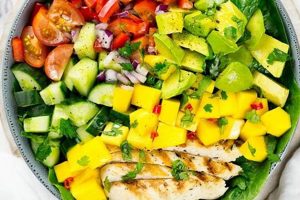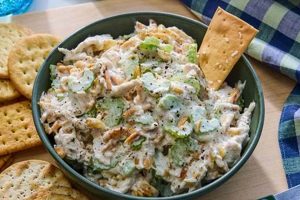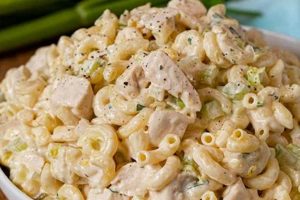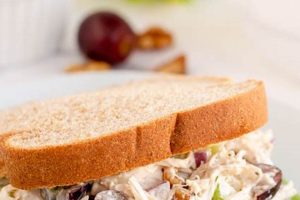Combining cooked pasta with a mixture of shredded chicken, mayonnaise, and often other ingredients like celery, onion, and grapes creates a cold pasta salad. This dish offers a versatile and customizable base, allowing for variations based on personal preferences. For example, some might add curry powder, nuts, or dried fruits for a unique flavor profile, while others prefer a simpler version with just chicken, mayonnaise, and celery.
This type of pasta salad provides a convenient and satisfying meal, ideal for picnics, potlucks, or light lunches. Its popularity stems from the ease of preparation, relatively inexpensive ingredients, and the ability to make large batches for gatherings. Historically, variations of chicken salad existed before refrigeration, but the modern iteration likely gained popularity in the mid-20th century as refrigeration became more common, making mayonnaise-based salads safer and more accessible.
Further exploration of this culinary concept will cover ingredient selection, preparation techniques, variations, nutritional information, and tips for successful execution. This information will empower readers to create their own delicious and personalized versions of this classic dish.
Tips for Creating Excellent Pasta Chicken Salad
Achieving a flavorful and well-balanced pasta chicken salad requires attention to detail. The following tips offer guidance for optimal results.
Tip 1: Cook Pasta Al Dente: Pasta cooked to a firm texture holds its shape better in the salad and prevents a mushy consistency. Overcooked pasta absorbs more dressing, leading to a less appealing final product.
Tip 2: Chill All Ingredients Thoroughly: Using chilled chicken, pasta, and other components ensures food safety and helps the salad maintain its temperature for longer, preventing mayonnaise-based dressings from becoming overly runny.
Tip 3: Use High-Quality Mayonnaise: The mayonnaise serves as the base of the dressing, impacting the overall flavor significantly. Opting for a high-quality mayonnaise elevates the taste profile.
Tip 4: Balance Flavors and Textures: Incorporating contrasting textures like crunchy celery or nuts with softer elements like grapes or dried cranberries adds complexity. Consider adding a touch of acidity from lemon juice or vinegar to balance the richness of the mayonnaise.
Tip 5: Season Appropriately: Salt and pepper are essential, but consider experimenting with other seasonings like onion powder, garlic powder, paprika, or herbs to enhance the flavor profile. Taste and adjust seasonings throughout the preparation process.
Tip 6: Avoid Overmixing: Gentle mixing prevents the chicken from shredding excessively and maintains the integrity of the other ingredients.
Tip 7: Refrigerate Before Serving: Allowing the salad to chill for at least 30 minutes before serving allows the flavors to meld and enhances the overall experience. This also improves food safety.
By following these tips, one can create a pasta chicken salad that is not only delicious but also visually appealing and texturally satisfying. Careful attention to these details elevates a simple dish into a culinary delight.
These insights provide a comprehensive guide to crafting a superior pasta chicken salad, leading to a satisfying and enjoyable dining experience.
1. Chicken (cooked, shredded)
Chicken serves as the foundational protein source in chicken salad with pasta. The cooking method and shredding process significantly influence the final dish’s quality. Overcooked chicken becomes dry and loses flavor, while undercooked chicken presents food safety risks. Proper shredding ensures the chicken integrates well with other ingredients, contributing to a desirable texture. For instance, poaching or baking chicken breasts results in tender, flavorful meat suitable for shredding. Boiling, while faster, may result in less flavorful chicken. Shredding by hand or using two forks provides optimal control over the size and texture of the chicken pieces.
The choice of chicken, whether from a whole roasted bird, pre-cooked rotisserie chicken, or individual breasts, affects both flavor and preparation time. Bone-in, skin-on chicken offers richer flavor but requires more preparation. Boneless, skinless chicken breasts offer convenience. Rotisserie chicken provides a shortcut, but its seasoning may influence the overall flavor profile of the salad. Understanding these nuances allows for informed decisions aligned with individual preferences and time constraints. Employing appropriate cooking and shredding techniques ensures the chicken contributes optimally to the final product.
Successfully integrating cooked, shredded chicken into pasta salad elevates the dish beyond a simple combination of ingredients. The chicken’s preparation dictates its contribution to the final product’s overall quality, impacting flavor, texture, and food safety. Thoughtful consideration of these factors ensures a satisfying culinary experience.
2. Pasta (cooked, cooled)
Pasta selection and proper cooking contribute significantly to a successful chicken salad recipe with pasta. The pasta’s shape, size, and texture influence the dish’s overall appeal and how well it holds the other ingredients. Small to medium-sized pasta shapes, such as rotini, farfalle, or penne, work well because their crevices capture the dressing and other components. Long, thin pasta like spaghetti or linguine, while suitable for other dishes, may prove cumbersome within a pasta salad context. Overcooked pasta becomes mushy, resulting in an unpleasant texture and an inability to absorb the dressing effectively. Conversely, undercooked pasta presents a hard, unappetizing texture. Cooking pasta “al dente,” or to the point of firmness, provides the ideal balance. Cooling the pasta completely before incorporating it into the salad prevents the mayonnaise-based dressing from thinning and the chicken from becoming warm.
Consider the impact of different pasta types. Gluten-free pasta offers an inclusive option for those with dietary restrictions, while whole wheat pasta adds nutritional value. The pasta choice also interacts with the other components. For example, a robust, textured pasta like rotini pairs well with a creamy, flavorful dressing, while a delicate pasta shape might benefit from a lighter vinaigrette. Cooling the pasta rapidly by rinsing it under cold water after draining helps to stop the cooking process and maintain the desired “al dente” texture. This rapid cooling also prevents the pasta from sticking together, ensuring a more pleasant eating experience. Leaving the pasta to cool at room temperature may lead to a gummy texture.
Properly cooked and cooled pasta forms the structural backbone of chicken salad, directly impacting the final dish’s overall quality. The pasta’s ability to hold its shape, absorb the dressing, and complement the other ingredients relies heavily on careful selection and cooking technique. Attention to these factors distinguishes a mediocre pasta salad from a truly enjoyable one.
3. Mayonnaise (base)
Mayonnaise serves as the foundational binding agent and flavor enhancer in chicken salad with pasta. Its emulsification of oil and egg yolks creates a creamy texture that coats the other ingredients, holding them together and contributing richness. The quality of mayonnaise significantly impacts the overall flavor profile. A higher quality mayonnaise, typically made with better oils and fewer additives, imparts a cleaner, more nuanced flavor compared to a lower quality counterpart, which may contain artificial flavors and preservatives that can detract from the dish’s overall taste. Mayonnaise choice influences not only flavor but also texture. Different brands and types of mayonnaise possess varying consistencies. A thicker mayonnaise creates a denser, creamier salad, while a thinner one results in a lighter, looser texture. For example, using a homemade mayonnaise with extra virgin olive oil adds a distinct richness and depth of flavor compared to a commercially produced mayonnaise made with soybean oil. The amount of mayonnaise used also plays a crucial role, as too much can overwhelm the other ingredients, while too little results in a dry, less cohesive salad.
Beyond its primary function as a binder, mayonnaise contributes to the overall sensory experience. Its tangy notes, derived from vinegar or lemon juice, balance the richness of the chicken and the fattiness of any added nuts or seeds. This balance prevents the salad from becoming overly heavy or cloying. Furthermore, mayonnaise acts as a flavor carrier, distributing seasonings throughout the salad and ensuring a consistent taste experience. Consider the interplay between mayonnaise and additional flavor components. The subtle tang of mayonnaise complements the sweetness of dried cranberries or the savory notes of chopped celery. This interplay allows for a complex flavor profile that goes beyond the simple sum of its parts. Practical applications include adjusting the amount of mayonnaise to achieve the desired consistency, incorporating flavored mayonnaises like chipotle or garlic, or even substituting plain Greek yogurt for a lighter, tangier alternative.
Understanding mayonnaise’s role in chicken salad with pasta extends beyond simply including it in the recipe. It involves a nuanced appreciation of how this key ingredient contributes to texture, flavor, and overall balance. Careful consideration of mayonnaise type and quantity, coupled with an awareness of its interaction with other ingredients, allows for the creation of a truly exceptional chicken salad. Overlooking these aspects can result in a dish that falls short of its full potential. The interplay between mayonnaise and other components dictates the final product’s overall quality and satisfaction.
4. Seasoning (salt, pepper)
Seasoning forms the foundation of flavor development in any culinary creation, and chicken salad with pasta is no exception. Salt and pepper, the quintessential seasonings, play a crucial role in enhancing the inherent flavors of the ingredients and creating a balanced, palatable dish. Their judicious use elevates the overall sensory experience from bland and uninspired to savory and satisfying. Exploring the nuances of seasoning with salt and pepper reveals their profound impact on this seemingly simple dish.
- Salt’s Role Beyond Salinity
Salt’s function extends beyond simply adding saltiness. It amplifies the flavors of other ingredients, allowing the subtleties of the chicken, vegetables, and mayonnaise to shine through. Salt also plays a critical role in moisture retention and preservation, influencing the final product’s texture and shelf life. In chicken salad, salt enhances the chicken’s savory notes, making it more pronounced, while simultaneously balancing the richness of the mayonnaise and the sweetness of any added fruits or vegetables. Using too little salt results in a flat, underwhelming flavor profile, while excessive salt renders the salad inedible. Different types of salt, such as kosher salt or sea salt, possess varying levels of salinity and mineral content, subtly influencing the final taste. Understanding these nuances allows for precise control over the flavor profile.
- Pepper’s Contribution to Complexity
Pepper introduces complexity and depth to chicken salad, providing a subtle heat and a contrasting bite that complements the creamy texture. Black pepper, the most common variety, offers a sharp, pungent flavor, while white pepper provides a milder, earthier taste. Freshly ground pepper delivers a more intense aroma and flavor compared to pre-ground pepper, which loses its potency over time. The amount of pepper used should complement, not overpower, the other flavors. A delicate balance ensures the pepper enhances the overall taste without creating an unpleasant burning sensation. Consider exploring other pepper varieties, such as green peppercorns or pink peppercorns, for unique flavor profiles.
- Balancing Salt and Pepper
The interplay between salt and pepper is essential for achieving a well-balanced flavor profile. The proper ratio of salt to pepper varies based on personal preference and the other ingredients in the salad. Generally, a slightly higher proportion of salt to pepper creates a savory foundation, while increasing the pepper adds a more pronounced spiciness. Tasting and adjusting seasoning throughout the preparation process is crucial for achieving the desired balance. For example, if grapes are included, a slightly higher salt content may be needed to balance their sweetness. Conversely, if using a spicy brown mustard, a more conservative approach to pepper might be appropriate.
- Seasoning Beyond the Basics
While salt and pepper are foundational, other seasonings can further enhance the flavor profile of chicken salad with pasta. Garlic powder, onion powder, paprika, or dried herbs can complement the existing flavors and add complexity. Experimentation is key. For instance, a dash of smoked paprika adds a subtle smoky depth, while dried dill introduces a fresh, herbaceous note. However, caution is advised. Over-seasoning can easily overwhelm the delicate balance of the salad, masking the core flavors rather than enhancing them. A judicious approach, starting with small amounts and tasting frequently, ensures the additional seasonings complement the existing flavors without dominating the palate.
Mastering the art of seasoning with salt and pepper elevates chicken salad with pasta from a simple combination of ingredients to a flavorful, well-balanced dish. Understanding the nuances of these seemingly basic seasonings allows for precise flavor control and customization, ensuring a satisfying culinary experience. The interplay between salt, pepper, and other complementary seasonings creates a symphony of flavors that elevates the dish beyond the sum of its parts. Attention to these details marks the difference between a mediocre salad and a truly exceptional culinary creation.
5. Vegetables (celery, onion)
Vegetables contribute crucial textural and flavor dimensions to chicken salad with pasta, elevating it beyond a simple protein and carbohydrate combination. The strategic inclusion of vegetables like celery and onion introduces contrasting crispness and aromatic complexity, transforming the overall sensory experience. Understanding the specific roles these vegetables play within the dish highlights their importance and informs optimal preparation and incorporation techniques.
- Celery: The Crispness Factor
Celery provides a refreshing crunch, contrasting with the softer textures of the chicken and pasta. Its subtle, slightly vegetal flavor complements the richer elements without overwhelming the palate. Finely diced celery distributes evenly throughout the salad, ensuring a consistent textural experience in each bite. The fibrous stalks offer a satisfying chew, while the leaves contribute a mild, herbaceous note. Celery’s high water content also adds moisture to the salad, preventing dryness. However, excessive celery can lead to an overwhelming vegetal flavor and watery consistency, necessitating careful portioning.
- Onion: The Aromatic Foundation
Onion introduces a pungent, savory depth, balancing the richness of the mayonnaise and adding complexity to the flavor profile. The type of onion chosen significantly influences the final result. Red onion offers a sharp, slightly sweet flavor, while yellow or white onions provide a more pungent bite. Finely dicing or mincing the onion ensures its flavor disperses evenly without overpowering the other ingredients. Macerating the onion in cold water or vinegar before adding it to the salad mellows its sharpness, making it more palatable for those sensitive to strong onion flavors. Overpowering onion flavor can negatively impact the overall balance, requiring careful consideration of onion type and preparation method.
- Beyond Celery and Onion: Expanding the Vegetable Palette
While celery and onion represent common additions, other vegetables can further enhance chicken salad with pasta. Bell peppers, diced carrots, or chopped water chestnuts introduce additional textural and flavor dimensions. Bell peppers contribute sweetness and a crisp bite, while carrots offer sweetness and a slightly firmer texture. Water chestnuts provide a unique, delicate crunch. The choice of additional vegetables depends on personal preference and desired flavor profiles. Integrating a variety of vegetables enhances both the nutritional value and the sensory complexity of the salad. However, maintaining a balance between the different vegetable flavors and textures is crucial for achieving a harmonious final product.
- Preparation and Incorporation Techniques
Proper preparation ensures the vegetables contribute optimally to the salad. Washing and thoroughly drying all vegetables prevents excess moisture from diluting the dressing. Uniform dicing or mincing ensures even distribution of flavor and texture. Adding the vegetables towards the end of the mixing process prevents overmixing and maintains their structural integrity. Consider blanching or roasting certain vegetables, such as bell peppers or carrots, to enhance their sweetness and soften their texture before adding them to the salad. These techniques influence the vegetables’ flavor, texture, and integration within the overall dish. Careful consideration of these factors elevates the final product from a simple mixture to a well-balanced, texturally and flavorfully complex salad.
The strategic incorporation of vegetables like celery and onion, along with other complementary options, transforms chicken salad with pasta into a multi-dimensional culinary experience. Their contributions extend beyond mere additions, playing crucial roles in flavor balance, textural contrast, and overall appeal. Careful selection, preparation, and incorporation techniques ensure these vegetables enhance, rather than detract from, the final product. The interplay between the vegetables, the chicken, the pasta, and the dressing dictates the overall quality and enjoyment of the dish. Understanding these nuances elevates the creation of chicken salad with pasta from a simple assembly process to a culinary endeavor.
6. Enhancements (grapes, nuts)
Enhancements, such as grapes and nuts, contribute nuanced dimensions to chicken salad with pasta, transforming a basic dish into a more complex and satisfying culinary experience. These additions introduce contrasting textures, subtle sweetness, and satisfying complexity, elevating the overall sensory profile. Careful selection and incorporation of these enhancements are crucial for maximizing their beneficial impact.
Grapes offer a burst of sweetness and a juicy texture that contrasts with the savory chicken and creamy mayonnaise. The natural sugars in grapes complement the savory elements, preventing the salad from becoming overly rich or one-dimensional. Green grapes provide a tartness, while red or black grapes offer a milder sweetness. Halving or quartering larger grapes ensures even distribution and prevents them from dominating each bite. The inclusion of grapes also introduces a visual appeal, adding pops of color and brightness to the salad.
Nuts contribute both textural contrast and flavor complexity. Their inherent crunch provides a satisfying counterpoint to the softer ingredients, while their distinct flavors enhance the overall profile. Almonds offer a neutral, buttery flavor, while walnuts provide a slightly earthy, more assertive taste. Pecans introduce a rich, sweet nuttiness, while toasted slivered almonds offer a crisp, nutty flavor. Chopping or coarsely grinding the nuts ensures even distribution and prevents large pieces from overwhelming the other components. The healthy fats present in nuts also contribute to satiety, making the salad a more satisfying meal.
The synergistic interplay between grapes and nuts is key to their enhancement of chicken salad with pasta. The sweetness of grapes balances the richness of nuts, preventing the salad from becoming overly heavy. Their contrasting textures, the juicy pop of grapes against the satisfying crunch of nuts, add a dynamic element to each bite. Consider the combination of walnuts and red grapes for a balanced sweetness and crunch, or toasted almonds with green grapes for a brighter, tangier flavor profile. The practical application of these enhancements involves selecting high-quality ingredients and incorporating them in appropriate proportions. Overuse of either grapes or nuts can lead to an imbalance in flavor and texture, diminishing the overall enjoyment. Thoroughly incorporating these enhancements throughout the salad ensures a consistent flavor and texture experience in each bite.
Careful consideration of these enhancements elevates chicken salad with pasta from a simple staple to a more refined and satisfying dish. Their strategic inclusion offers a practical approach to enhancing flavor, texture, and overall appeal, contributing to a more enjoyable culinary experience.
Frequently Asked Questions
This section addresses common inquiries regarding chicken salad with pasta, providing clear and concise information to facilitate successful preparation and enjoyment.
Question 1: What type of pasta is best suited for chicken salad?
Small to medium-sized pasta shapes, such as rotini, farfalle, fusilli, or penne, are generally preferred. These shapes hold the dressing well and provide textural interest. Avoid long, thin pasta like spaghetti or linguine, as these can become cumbersome to eat in a salad.
Question 2: Can rotisserie chicken be used?
Rotisserie chicken offers a convenient shortcut. However, its pre-existing seasoning may influence the final flavor profile. Adjust additional seasonings accordingly.
Question 3: How long can chicken salad with pasta be stored?
Properly stored in an airtight container in the refrigerator, chicken salad with pasta typically lasts for three to five days. Always check for spoilage before consuming.
Question 4: Can this salad be frozen?
Freezing is not recommended. Mayonnaise-based dressings separate and lose their creamy texture upon thawing, resulting in an undesirable consistency. The pasta may also become mushy after freezing.
Question 5: How can one reduce the calorie content?
Using Greek yogurt in place of some or all of the mayonnaise, choosing whole wheat pasta, and incorporating more vegetables are effective strategies for reducing the calorie content without sacrificing flavor or satisfaction. Consider using skinless chicken breast and reducing the amount of added nuts.
Question 6: What are some variations to the classic recipe?
Numerous variations exist. Consider adding curry powder for an Indian-inspired twist, incorporating dried cranberries and pecans for a sweet and savory combination, or using a pesto-based dressing instead of mayonnaise for a Mediterranean flair. Experimenting with different herbs, spices, and vegetables allows for customization based on individual preferences.
Addressing these frequently asked questions provides a comprehensive understanding of key aspects related to chicken salad with pasta preparation and storage. This information empowers individuals to create and enjoy this versatile dish successfully.
This concludes the FAQ section. The following sections will explore additional related topics.
Chicken Salad Recipe with Pasta
Exploration of this dish reveals a deceptively simple composition yielding diverse possibilities. Careful consideration of core componentschicken, pasta, mayonnaise, seasoning, vegetables, and enhancementsallows for a personalized approach to flavor and texture. Proper cooking techniques, ingredient selection, and balanced flavor combinations are crucial for achieving optimal results. Understanding the interplay between these elements distinguishes a mediocre rendition from a truly satisfying culinary creation.
The adaptability of this dish offers a platform for culinary exploration and personal expression. From classic combinations to innovative variations, the potential for customization remains vast. Continued experimentation and refinement of technique promise ever-evolving iterations of this versatile and enduring culinary staple.






